Whaia te ara o te Kareao: Taoka from the Ngāi Tahu archive
Feb 12, 2025

Kareao is the official website of the Ngāi Tahu Archive. Named after the ubiquitous supplejack, Kareao is an apt metaphor for the website which leads from one point to another, linking, connecting, and ultimately taking explorers in myriad directions of discovery. Whaia te ara o te Kareao will be a regular TE KARAKA feature sharing important and interesting stories from the Ngāi Tahu Archive with our readers, which they can explore further on Kareao.
Maahunui Māori Council
The Maahunui Maori Council was one of 19 councils set up under the Maori Councils Act 1900, which offered Māori communities a limited measure of local self-government. The Act built on previous attempts by Māori leaders to obtain self-government through the legislative process. It also responded to health reforms suggested by Māori political leaders such as James Carroll and Apirana Ngata, in response to the epidemics of introduced diseases that had devastated Māori. Māori councils were to have six to 12 councillors elected for a period of three years. They were empowered to make by-laws related to health, sanitation and the sale of alcohol within their kāika.
Following passage of the act, Kāi Tahu leaders convened a hui on 11 March 1902 at Wairewa Marae to discuss the proposed new councils. Delegates from across the Kāi Tahu takiwā enjoyed a day of ‘glorious weather’ and fun at the Akaroa County Racing Club’s annual race meeting at Wairewa before settling in for a full night of rigorous discussion. Native Minister, the Hon James Carroll (Timi Kara), was grilled late into the night on the provisions of the Act.
The South Island was subsequently divided into three divisions. The northern boundary ran from Māwhera to the mouth of the Clarence River and the southern boundary, from Okura to the mouth of the Waitaki. The middle section was to be the jurisdiction of the Maahunui Maori Council, named after Māui’s famous waka from which he fished up Te Ika-a-Māui. Variant spellings of the name appeared during the council's years of operation, but the Chair, Taituha Hape, confirmed in 1902 that Maahunui was correct. The southern council was called Araiteuru. Elections for the first council were held at Tuahiwi in September 1902.
Enthusiasm and expectations for this initiative in self-government were high among Māori across the country, although not all elements of the act or by-laws were equally popular. As in other places, local Kāi Tahu communities set up komiti marae to support the councils and help enforce their by-laws. While all Māori councillors were men, komiti marae frequently included wāhine among their ranks.
Government support for the project was, however, limited at best. Council income came from dog licenses, fines, voluntary donations from rents and fundraising events. This was rarely enough to cover governance costs, and the projects delegated to the councils. In 1906, the Maahunui and Araiteuru councils held a combined hui at Arowhenua to discuss the insufficient nature of council funding and the non-payment of agreed grants by the government. Despite their limited resources, councils worked hard to organise events, maintain social order within their communities and enact reforms they felt would enhance the lives of their whānau and hapū.
By the late 1910s, the combination of financial challenges with new priorities such as the reinvigoration of Te Kerēme in 1907, saw the importance of Māori councils wane, although the flaxroots organising and fundraising efforts continued, albeit in other forms.
IN 1906, THE MAAHUNUI AND ARAITEURU COUNCILS HELD A COMBINED HUI AT AROWHENUA TO DISCUSS THE INSUFFICIENT NATURE OF COUNCIL FUNDING AND THE NON-PAYMENT OF AGREED GRANTS BY THE GOVERNMENT.
DESPITE THEIR LIMITED RESOURCES, COUNCILS WORKED HARD TO ORGANISE EVENTS, MAINTAIN SOCIAL ORDER WITHIN THEIR COMMUNITIES AND ENACT REFORMS THEY FELT WOULD ENHANCE THE LIVES OF THEIR WHĀNAU AND HAPŪ.
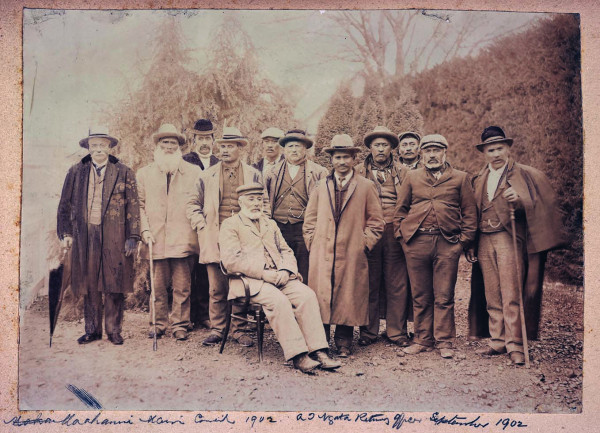
Image Reference: PA1-q-1136-64-01, Alexander Turnbull Library (copy held at Ngāi Tahu Archive).
This photograph of the first Maahunui Maori Council was taken at their inaugural meeting held at Tuahiwi from 9–11 September 1902. Apirana Ngata was the returning officer for the elections held on the first day, and the newly-elected council met that evening. Taituha Hape was elected chair and the name ‘Maahunui’ was approved. Council members also discussed at length the by-laws and regulations put in place by other Māori councils around the country.
Back row (left to right): Apera Pirini Ruru (Port Levy), Hoani Te Hau Pere (Little River), John Tini (Little River). Second row (left to right): James Charles Rickus, (Waihao), Henare Kahu (Temuka), Hoani Tikao Wira (Temuka), Joseph Horomona (Kaiapoi), Wepu Hopa (Taumutu), John Watson (Rapaki), Thomas Eustace Green (Kaiapoi). Front row: Taituha Hape (Chair) and Apirana Ngata (returning officer).

Image Reference: PhotoColl22_ IMG00695, Christchurch City Library Heritage Image Collection (copy held at Ngāi Tahu Archive).
On 12 and 13 November 1903, the Maahunui Maori Council hosted a Māori carnival at Lancaster Park in Christchurch to raise funds for the council’s work. About 200 Ngāi Tahu participated in the event, including representatives from Tuahiwi, Taumutu, Koukourarata, Wairewa, Rāpaki, and Arowhenua. After a grand procession of performers who marched from Cathedral Square to the park, led by the Woolston Band, the carnival opened with a pōwhiri. Festivities included a hāngi, tug-of-war, poi, and a haka to commemorate the waka Mahanui.
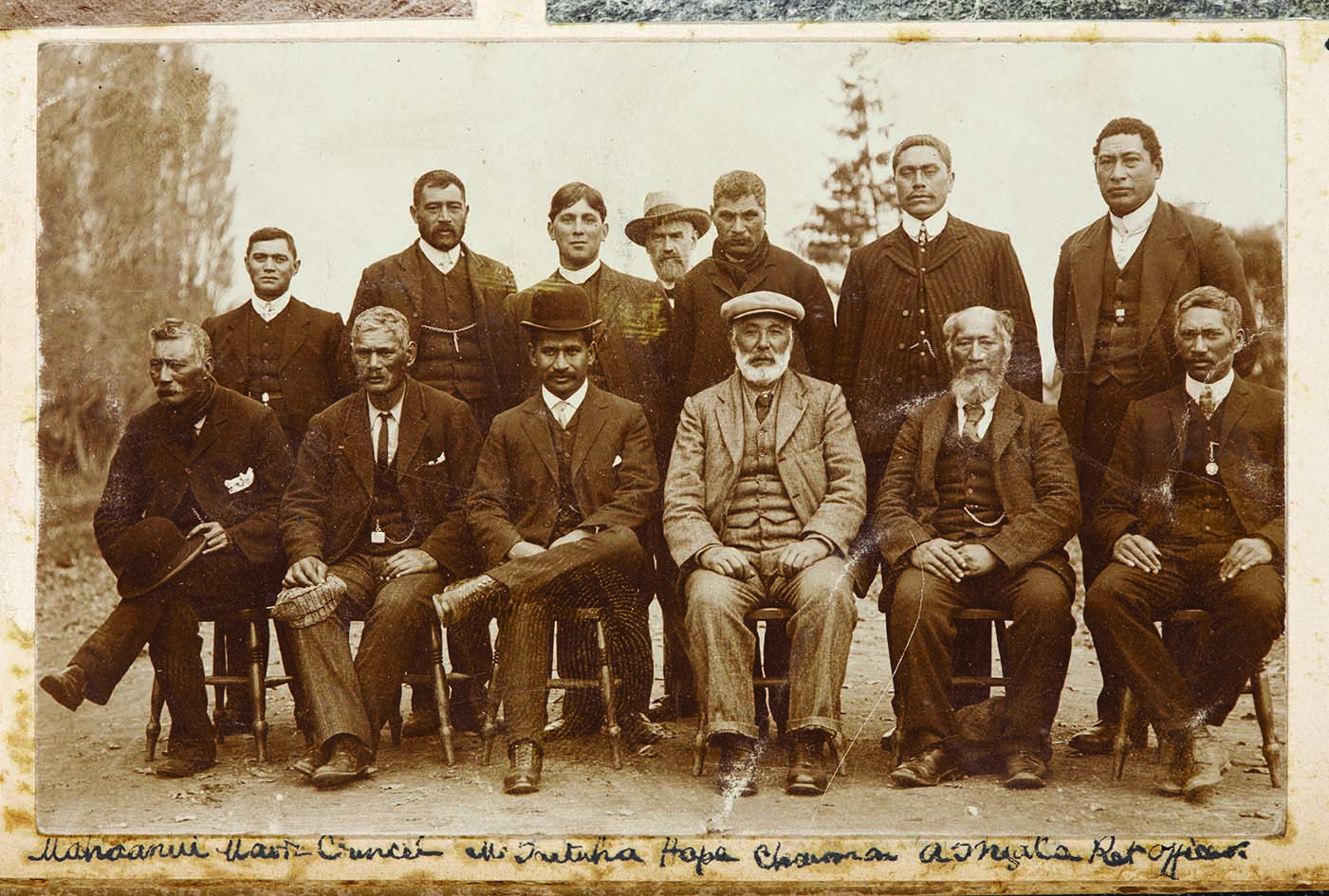
Image Reference: PA1-q-1128-5-4_043, Alexander Turnbull Library (copy held at Ngāi Tahu Archive).
At the first hui of newly elected councillors (7–9 May 1909), discussion centred on the suppression of the liquor trade within kāika and the promotion of public health measures. The council also lobbied the newly-appointed Minister for Māori Councils, Apirana Ngata, for greater government resources for footpaths, drainage and running costs for the council. An open session on the second day enabled delegates from across the motu to address the Minister on matters ranging from land compensation and fishery rights to government loans for local infrastructure. A reception in honour of Ngata, which included highland dancing, waiata and haka, was held that evening and was the first use of the rūnaka hall’s newly-installed gas lighting.
Newly-elected councillors at their first hui 7–9 May 1909. Front row (left to right): Henare Rāwiri Te Maire (Morven), Teone Wira (Arowhenua), Hon. Apirana Ngata, Taituha Hape, Chairman (Tuahiwi), Hoani Korehe Kaahu (Temuka), Ihakara Wiremu Karaitiana (Tuahiwi). Back row (left to right): Mana Himiona te Ataotu (Kaikōura), Apera Pirimi Ruru (Port Levy), William Daniel Barrett/Wiremu Taniera Parete (Poutini), Helyar Wedderburn Bishop (Stipendiary Magistrate), Teone Watene (Rāpaki). The two other council members identified in the sources are Hape Marakaia Uru and Atarea Te Maiharanui Maopo. As yet, however, we have not been able to confidently identify which of the men on the right of the back row is Uru and which is Maopo.
AN OPEN SESSION ON THE SECOND DAY (OF THE FIRST HUI OF NEWLY ELECTED COUNCILLORS) ENABLED DELEGATES FROM ACROSS THE MOTU TO ADDRESS THE MINISTER ON MATTERS RANGING FROM LAND COMPENSATION AND FISHERY RIGHTS TO GOVERNMENT LOANS FOR LOCAL INFRASTRUCTURE.
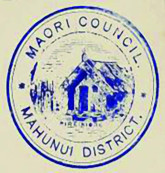 Each district council had their own seal, mandated by the Maori Council Act 1900, for the ‘purpose of authenticating documents issued by it’. The stamps were of a universal design chosen by the central government and feature the words ‘Pire Kiore’ underneath a picture of a whare.
Each district council had their own seal, mandated by the Maori Council Act 1900, for the ‘purpose of authenticating documents issued by it’. The stamps were of a universal design chosen by the central government and feature the words ‘Pire Kiore’ underneath a picture of a whare.
‘Te Piri Kiore’ (the Rat Bill) was initially the nickname Māori gave to the Bubonic Plague Prevention Act 1900, which was one of the catalysts for devolving some public health duties to Māori councils and the nickname therefore also became attached to the Māori councils. The title ‘Pire Kiore’ was also taken up by some as a criticism of the Maori Lands Administration Act that was introduced at the same time.
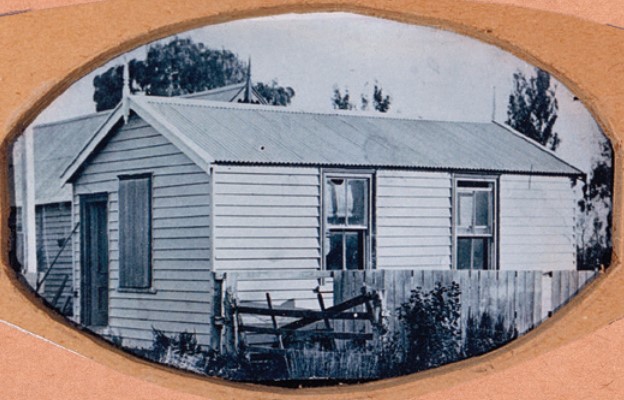
Image Reference: 2018-0462-1-0002, Art and Taoka Collection, Ngāi Tahu Archive.
The council chambers at Tuahiwi were described by one journalist in 1909 as a ‘comfortable little chamber adjoining the Runanga Hall’. The council chambers were also used for other meetings, such as the Ladies’ Reception Committee during their planning for a fancy-dress ball to raise funds for 6000 tītī to be sent to Māori soldiers in 1918.
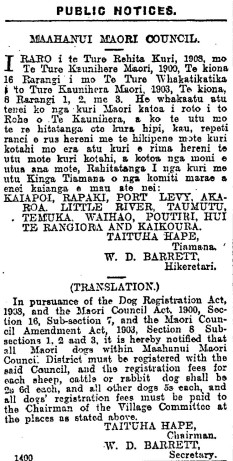
Māori councils were empowered to issue a range of licences and registrations. Dog and cattle licences were one of the councils’ main sources of income, but never provided enough revenue to fund the multitude of issues for which councils were responsible. These ranged from noxious weeds to eel weir management and the licensing of Māori births and deaths. Taituha Hape was elected chairman at the first council meeting on 9 September 1902 and remained in the role for over a decade. William Barrett was elected to the council in 1909 and went on to also serve on the Ngaitahu Census Committee and Ngaitahu Trust Board.
Image Reference: Lyttelton Times, 7 February 1911, p.10.
Article References:
Maori Councils Act 1900
‘Page 4 Advertisements Column 4,’ Evening Post, 8 May 1901, p.4.
‘Sporting Intelligence,’ Evening Star, 15 March 1902, p.3.
‘Maori Council,’ The Press, 10 September 1902, p.4.
‘Mahunui Maori Council,’ The Press, 11 September 1902, p.3.
‘The Maori Council,’ Temuka Leader, 19 July 1906, p.2.
‘The Hon. A. T. Ngata’, Lyttelton Times, 10 May 1909, p.3.
‘The Country,’ The Press, 16 July 1918, p.3.
Athol Anderson, Judith Binney and Aroha Harris, Tangata
Whenua: An Illustrated History, (Wellington: Bridget Williams
Books, 2014), pp. 295 & 328–333.
Takerei Norton, ‘Hoani Te Hau Pere’, Tangata Ngāi Tahu:
People of Ngāi Tahu, Volume II, Helen Brown and Michael
J. Stevens eds., (Christchurch: Te Rūnanga o Ngāi Tahu with
Bridget Williams Books, 2022), pp.194–195.